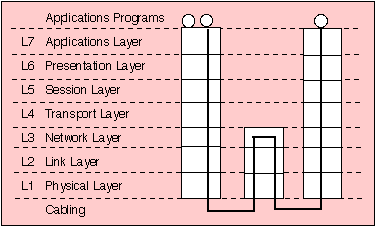
For many years the OSI reference model was the core reference framework used by all communications courses. It remains a theoretical reference model that can be used to compare protocols and stacks.
The OSI reference model specifies standards for describing "Open Systems Interconnection" with the term 'open' chosen to emphasise the fact that by using these international standards, a system may be defined which is open to all other systems obeying the same standards throughout the world. The definition of a common technical language has been a major catalyst to the standardisation of communications protocols and the functions of a protocol layer.

The seven layers of the OSI reference model showing a connection between two end systems communicating using one intermediate system.
The structure of the OSI architecture is given in the figure above, which indicates the protocols used to exchange data between two users A and B. The figure shows bidirectional (duplex) information flow; information in either direction passes through all seven layers at the end points. When the communication is via a network of intermediate systems, only the lower three layers of the OSI protocols are used in the intermediate systems.
The OSI layers may be summarised by:
The communications engineer is concerned mainly with the protocols operating at the bottom four layers (physical, data link, network, and transport) in the OSI reference model. These layers provide the basic communications service. The layers above are primarily the concern of computer scientists who wish to build distributed applications programs using the services provided by the network.
The two lowest layers operate between adjacent systems connected via the physical link and are said to work "hop by hop". The protocol control information is removed after each "hop" across a link (i.e. by each System) and a suitable new header added each time the information is sent on a subsequent hop.
The network layer (layer 3) operates "network-wide" and is present in all systems and responsible for overall co-ordination of all systems along the communications path.
The layers above layer 3 operate "end to end" and are only used in the End Systems (ES) which are communicating. The Layer 4 - 7 protocol control information is therefore unchanged by the IS in the network and is delivered to the corresponding ES in its original form. Layers 4-7 (if present) in Intermediate Systems (IS) play no part in the end-to-end communication.
A detailed example of the interaction between OSI layers is provided in an example.